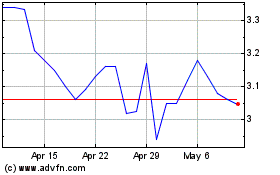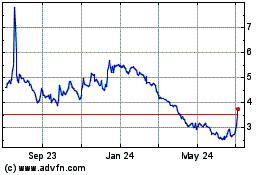By Anne Steele
In the face of stiff competition in a crowded music streaming
landscape, Pandora Media Inc. is fighting for listening time.
The internet-radio company, popular for its free personalized
music stations, has struggled as users have migrated to services
like Spotify AB and Apple Music that allow listeners to play
individual songs on demand. And ad dollars have followed.
Pandora's stock, once a Wall Street darling, has flagged, though
the company remains the largest streaming-music provider in the
U.S. Last year, a $480 million investment from Sirius XM Holdings
Inc. was followed by a management shake-up that brought Sling TV's
founding chief executive, Roger Lynch, to the helm. Mr. Lynch is
now leading Pandora's efforts to woo back listeners and
advertisers.
Hedging its bets on the future of music listening, Pandora last
March launched its own on-demand subscription service, Pandora
Premium. In December, it rolled out a feature allowing users of its
ad-supported radio tier to access about 30 minutes of free
on-demand listening in exchange for watching 15-second ads.
But Pandora also sees a future for its core ad-supported radio
and is doubling down on the technology that enabled it to provide
personalized music. Founded on a technology called the Music Genome
Project, a combination of humans and machines that helped it
analyze music and recommend songs for each listener, Pandora has
collected stores of data on music and its users.
Now Pandora is using its data to help advertisers better target
ads. It is also trying to apply similar analysis and algorithms to
nonmusic content such as podcasts, to be able to make the same type
of personalized recommendations.
Mr. Lynch discussed Pandora's data innovations, the perfect ad
length and the future of listening to music. Edited excerpts
follow.
Updating the service
WSJ: Pandora has been losing users. Why do you think that is,
and what is the most important thing for reversing it?
MR. LYNCH: It's a more competitive market than it used to be,
which means you need to make sure you're always innovating. One of
the main reasons people cite for why they might stop listening to
Pandora is the lack of the ability to listen to a song on demand.
We launched the premium product, which is all on demand, in April
of last year, but also in December we launched a new innovation
bringing on demand into our ad-supported product.
WSJ: Where are you looking for new subscribers, and how are you
thinking about drawing them in to Pandora?
MR. LYNCH: We have a three-tier model. We have our ad-supported
listeners. Then we have two subscription tiers: people who want an
ad-free version of Pandora for $5 a month or full on-demand service
for $10 a month. That's where we decided to capture the growth
that's happening in premium subscription services, while at the
same time going after people who will not pay.
WSJ: You have tons of users and lots of years of listening data.
Are there any untapped or undertapped areas where you think you can
use data to make the listening or ad experience better?
MR. LYNCH: An opportunity for us is to use it better in our
marketing. Today's marketing is less about big brand campaigns and
much more about using data to create a unique connection with an
individual. By unique, I mean targeted for that individual from
whatever data we know about you, and that's an opportunity Pandora
has underexploited because we have strength in data.
WSJ: Can you give an example of what they might look like?
MR. LYNCH: We can serve hyperpersonalized audio ads to
listeners, allowing advertisers to create thousands of versions of
an audio ad easily and efficiently. For example, listeners in San
Diego might hear something like, "Good morning San Diego, it's
going to be hot today. Come grab your iced coffee at (insert coffee
shop)." A New York listener might get something like, "Good morning
New York, it's cold out. Start your day with a warm latte from
(insert coffee shop)."
WSJ: What about users who don't want so many ads?
MR. LYNCH: Much like how we know what song is likely to be
positively received by a listener, we have a pretty good idea what
kind of ad they will be most receptive to, and when best to serve
an ad or not. We won't serve an ad if a listener has just
thumbed-down a song. We're also able to identify if a person
responds better to ads during particular times of day or days of
the week, if they prefer longer but fewer ads or shorter but more
frequent ones.
We personalize advertising to them in the same way we
personalize their music feed.
WSJ: Can you expand on what the Music Genome Project for
podcasts is?
MR. LYNCH: Over the past 12 years, Pandora has been analyzing
listener behavior to create a comprehensive view of the different
characteristics of users on our platform based on historical usage.
We understand the appetite for varieties of genres and audio
content, as well as the propensity to listen to Pandora during
certain times of day, or points in time -- during a morning
commute, for example. Now we are developing an algorithm that
allows us to predict what types of podcasts (sports, news, fashion,
etc.) will resonate with a particular user.
We'll be able to get as specific as the content of the episode,
and then match this information with listener preferences to make
recommendations.
The future of ads
WSJ: What are you looking at for listening in the car?
MR. LYNCH: We're in 200 car models already, and then you have
the growth of Android Auto and Apple CarPlay. That brings Pandora
to many more cars. So I see that as a big opportunity. The
challenge is, you have to make it as easy as pushing an "on"
button. If you think about how easy FM radio is today, I just get
in and push the button, and it plays. We have to make streaming
audio as easy as that, and one of the ways to do that can be
through voice navigation. Obviously, if you're driving a car,
you're otherwise engaged, and fooling around with any type of
physical interface is more challenging. So, if you can use voice to
navigate, you're going to be more in the mode of, let it take over
and play for me the things I like to listen to.
WSJ: How do you see the role of ad-supported music within the
broader music-listening ecosystem that we have?
MR. LYNCH: We do know that in any market, you have to segment
the market. There are people who will pay for a premium experience,
people who won't pay and people who will pay for something in
between. So it's very important that Pandora has the spectrum all
the way from the ad-supported up to the premium service, and I
don't see that changing.
Even though there's growth with subscriptions, you are going to
still see ad-supported audio continuing to be large, maybe the
largest, in terms of listeners at least across the U.S.
Ms. Steele is a Wall Street Journal reporter in Los Angeles. She
can be reached at anne.steele@wsj.com.
(END) Dow Jones Newswires
February 19, 2018 22:16 ET (03:16 GMT)
Copyright (c) 2018 Dow Jones & Company, Inc.
Sirius XM (NASDAQ:SIRI)
Historical Stock Chart
From Mar 2024 to Apr 2024

Sirius XM (NASDAQ:SIRI)
Historical Stock Chart
From Apr 2023 to Apr 2024
